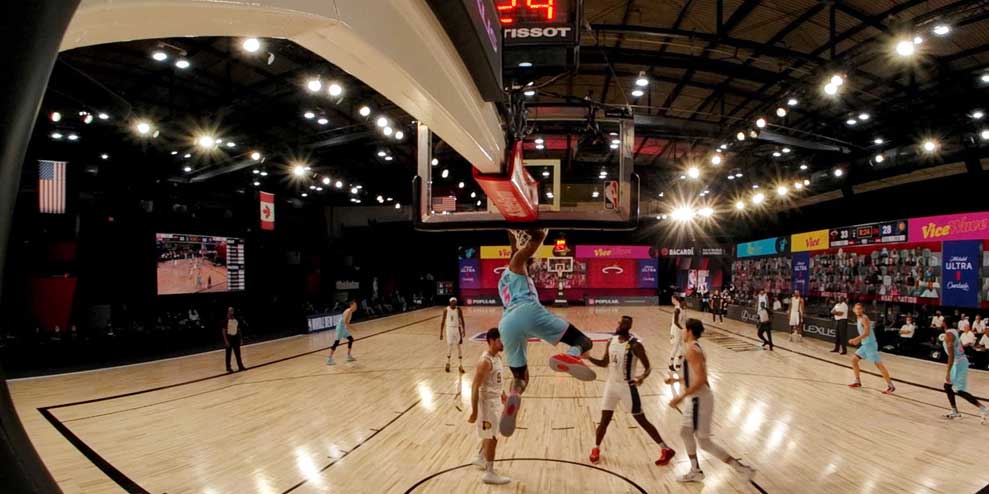If you’re not innovating, you’re not doing fans any favors
So far in 2020, brands and sports leagues have aimed high in recreating the fan experience. Despite countless attempts, I find that brands are too focused on looking backwards rather than ahead. Digital provides so much untapped potential when it comes to enriching spectatorship, yet experiments in digital have mostly aimed to recreate the fan experience rather than truly innovate.
As a former athlete and sports journalist, I’ve witnessed how sports spectatorship has evolved. Now, sports are at a crossroads—games are coming back, but fans mostly aren’t yet allowed inside. And while digital has been essential to breaking barriers between at-home fans and athletes, a new generation of sports experiences can go further in giving fans a voice through interactions and unexpected moments that delight.
The future of digital sports lies in the convergence of spectatorship at home and the sense of presence and excitement you feel courtside. Brands have a clear opportunity to enhance the fan experience this way, whether through innovative use of technology or tapping into a team’s community with increasing emotional resonance.
Tap into fandom.
Fan engagement was a hot topic at our Women in Sports Marketing Summit with Brand Innovators. Ashley Booker, who leads NBA partnership, music and cultural engagement strategies for Mtn Dew at PepsiCo, discussed how the brand activated fans in a culturally relevant way: It helped them up their GIF game while watching basketball through a collection of reaction GIFs, helping fans connect online as they reacted together to major moments in the game.
“Who is really glued to their screen watching commercials?” she said. “There’s this idea that we’re not only going to do a commercial but we’re going to add to the fan experience, we’re going to enhance or add value for the fans.” She likens innovation to the “cool shit test,” a benchmark for whether a creative idea is worth pursuing based on how much real value it provides fans.
A great example of this is how the NBA, Yahoo Sports and RYOT have come together to virtualize the audience experience by bringing the game to VR. With fans at home and unable to attend in-person, the experience reaches them where they are. This shows the potential of hosting games beyond just a single broadcast for TV or digital; instead, brands can enable more resonant experiences through a multi-platform approach that caters to specific contexts.
That’s an important distinction. I feel sports can go so much further—there’s so much untapped potential when you stop to consider the prevalence of digital communication and emerging content formats. Soul & Science, a program short in volumetric video by Intel Studios and delivered in augmented reality (AR) by MediaMonks, is another of my favorite examples of how digital formats can redefine spectatorship. The AR app immerses viewers by letting them view elite sports moves at any angle within their immediate surroundings, no matter where they are.
Act on consumer insights with agility.
To understand what resonates with your audience, tapping into community insights and having the agility to quickly shift gears is essential—especially when there’s still so much uncertainty about what sports will look like months or even a year from now. Like many other brands, Toyota had to quickly evolve the messaging it had prepared for the Olympics after the event was postponed until 2021. The brand was able to rapidly switch gears and retain relevance by keeping a pulse on its audience.
“We’re also using our social channels to understand consumer sentiment in general, and that’s one thing we’ve really homed in on: taking time to listen and to learn,” says Dedra DeLilli, group manager of Olympic/Paralympic marketing at Toyota. “And it’s nimbler than it’s ever been, it’s sensitive and ever-changing.”
In that respect, what really matters to the future of sports spectatorship is letting fans feel they have real impact over what they’re watching. Any sports fan will tell you there’s a gripping sense of drama in sports spectatorship—watching the rise of the underdog or the intense rivalry between teams play out in front of you.
Sports innovation should work to let fans truly feel a sense of meaning and belonging as they not only watch but engage in these experiences. A confluence between witnessing a game at home and feeling the energy of a game play out right in front of you is the next frontier for sports—and I hope to see it well beyond the recovery from the pandemic.
This article first appeared in musebycl.io
Seeking to build and grow your brand using the force of consumer insight, strategic foresight, creative disruption and technology prowess? Talk to us at +971 50 6254340 or mail: engage@groupisd.com or visit www.groupisd.com/story


